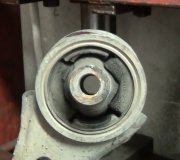To make the cotter pin hole accessible, the stud has to be rotated before it is inserted into the spindle. The ball is usually too tight to let you do that by hand. Stick a nail through the hole to use as a handle. You can hook a box wrench over the nail to use as a lever.
Another method is to turn the entire steering system before you draw the stud tight in the spindle. Once you see the hole will be accessible, tighten the nut enough so the stud will be held in place, then you can return the steering to any position that gives you the best working room.
I'm happy to hear you want to torque the nut, and you understand the importance of that. The tool to use for torquing the castle nut is an open-end crow's foot wrench, but that makes the entire tool assembly longer, so it throws off the calibration. Sometimes that crow's foot wrench, or some other special tool, is listed in the service manual, but then the torque spec will be adjusted accordingly. In this application, the tightness of the castle nut is not critical, so you can use common sense.
Even if you could set the tightness to specs, you still need to turn the nut tighter until the cotter pin hole lines up. If the spindle is made of cast iron, the final value could be 60 - 70 foot pounds. That shows there is a lot of leeway without compromising safety.
If the spindle is made of aluminum, it is going to crush and deform under the nut if it is tightened too much. The manufacturer picks a torque spec that is high enough to do the job of holding the stud tight, but low enough to not reach that point where the metal deforms. If you were to set the torque wrench to, say, ... 70 foot pounds, you'd find you'd never get there, or it would seem like it's taking forever. That is when the aluminum is deforming, but the stud isn't getting pulled into the tapered hole any tighter. This again is where we use common sense. If you use an open-end wrench that is a foot long, you need to pull on it with 55 pounds of force. That's a little more than the weight of a full five-gallon can of gas.
Monday, June 10th, 2019 AT 3:49 PM


